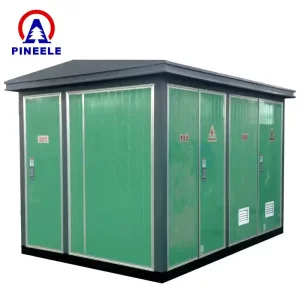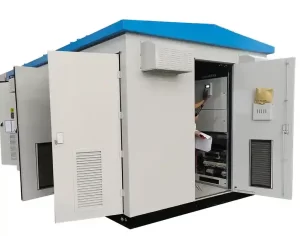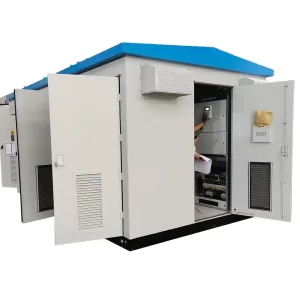Box-type substations—also known as prefabricated or compact substations—are becoming indispensable in modern electrical distribution networks. Especially the 11/0.4kV variant, which steps down medium voltage solutions (11kV) to standard low voltage (0.4kV), offers a ready-to-use, compact solution for industries, infrastructure, and urban utilities. This article explores the technical features, application scope, and leading manufacturers of 11/0.4kV box-type substations, helping decision-makers choose wisely and with confidence.

What Is an 11/0.4kV Box-Type Substation?
An 11/0.4kV box-type substation is a modular, factory-assembled power unit that integrates:
- Medium-voltage switchgear (incoming 11kV)
- Distribution transformer (usually oil-immersed or dry type)
- Low-voltage switchgear (400V outgoing feeders)
- Steel or aluminum-clad enclosure
The unit is designed for outdoor use and is typically prewired, pretested, and delivered as a plug-and-play package, reducing onsite installation time significantly.
Where Are They Used?
Box-type substations are especially useful in power distribution networks where compact size, safety, and ease of maintenance are essential. Typical applications include:
- Urban residential communities and commercial buildings
- Manufacturing plants and warehouses
- Hospitals and schools
- Highway service stations and airports
- Renewable energy systems such as wind and solar farms
- Smart city grid zones and utility upgrades
They are often installed near the load center, minimizing voltage drop and reducing transmission losses.
Industry Background and Market Trends
As countries invest in upgrading their power infrastructure and expanding urban centers, compact substations are witnessing growing demand. According to a report by MarketsandMarkets, the compact substation market is projected to surpass USD 13 billion by 2030, driven by space constraints and smart grid integration.
Key industry trends include:
- Rising adoption of smart monitoring és SCADA-ready units
- Shift toward biodegradable transformer oils és arc-proof designs
- Modular expansions that allow scalability for future load increases
Standards like IEC 62271-202, IEEE C37.20.1, and national grid codes guide the design, performance, and safety of these units.
Technical Specifications (Typical for 11/0.4kV Box-Type Substations)
| Parameter | Specification |
|---|---|
| Rated Voltage (HV side) | 11 kV |
| Rated Voltage (LV side) | 0.4 kV |
| Transformer Capacity | 250 – 2500 kVA |
| Cooling Type | ONAN (Oil Natural Air Natural) / AN |
| Frequency | 50 Hz / 60 Hz |
| Védelmi szint | IP44 to IP55 |
| Short-Circuit Withstand | Up to 25 kA |
| Enclosure Material | Galvanized steel / aluminum alloy |
| Standard Compliance | IEC 60076, IEC 62271, IEEE C57 |
Comparison with Conventional Substations
| Feature | Box-Type Substation | Traditional Substation |
|---|---|---|
| Footprint | Small | Large |
| Installation Time | 2–3 days | Weeks |
| Safety | Factory-tested, enclosed | More manual coordination |
| Cost (Overall) | Lower (fewer civil works) | Higher due to infrastructure |
| Mobility | Relocatable if needed | Stationary |
This makes box-type substations highly suitable for fast-paced projects and areas where land availability is limited.
Leading Manufacturers of 11/0.4kV Box-Type Substations
Several global and regional manufacturers have strong capabilities in designing and delivering 11/0.4kV substations:
- ABB (Hitachi Energy)
Known for precision-engineered solutions with IoT integration and global service coverage. - Schneider Electric
Offers box substations as part of their EcoStruxure platform for smart energy management. - PINEELE
A specialized manufacturer providing cost-effective, project-specific compact substations in Asia, Africa, and the Middle East. - Siemens Energy
Focuses on intelligent switchgear and modular solutions built to IEC and ANSI standards. - CG Power and TBEA
Well-established suppliers in emerging markets, offering ruggedized substations for tough environments.
How to Choose the Right Manufacturer
When evaluating substation manufacturers, focus on the following:
- Standards and Certifications: Look for IEC, IEEE, and ISO certifications.
- Customization Options: Does the supplier offer flexibility in switchgear brands, transformer types, and panel layouts?
- Delivery Lead Time: Especially important for time-sensitive projects.
- After-Sales Support: Availability of spare parts, technical documentation, and on-site training.
- Previous Projects and References: Case studies and real-world applications add credibility.
Frequently Asked Questions (FAQs)
A: Typically, a factory-assembled unit can be installed and commissioned within 2–5 days, depending on the site readiness and connection requirements.
A: Yes. While oil-immersed transformers are common, dry-type transformers can be used in environments with strict fire safety or indoor proximity constraints.
A: Routine checks on oil levels (if applicable), breaker condition, grounding systems, and thermal imaging are recommended annually.
The 11/0.4kV box-type substation is a compact, cost-efficient, and reliable solution for today’s power distribution challenges. Its modular design, fast deployment, and safety make it a preferred choice for modern urban and industrial developments.
Choosing a qualified manufacturer is key to ensuring durability, compliance, and ease of maintenance. By understanding the technical and operational aspects of these units, buyers and engineers can make well-informed decisions that align with project goals and power system performance.
Whether you’re powering a commercial complex, an industrial plant, or a new infrastructure development, an 11/0.4kV box-type compact substation guide offers a future-ready solution tailored for efficiency and scalability.







